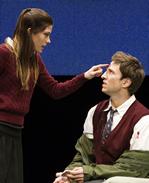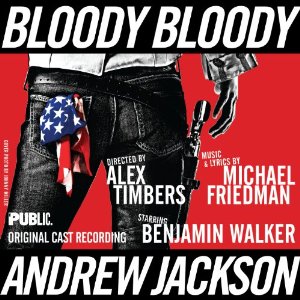SITE GUIDE
SEARCH
REVIEWS
REVIEW ARCHIVES
ADVERTISING AT CURTAINUP
FEATURES
NEWS
Etcetera and
Short Term Listings
LISTINGS
Broadway
Off-Broadway
NYC Restaurants
BOOKS and CDs
OTHER PLACES
Berkshires
London
California
New Jersey
DC
Connecticut
Philadelphia
Elsewhere
QUOTES
TKTS
PLAYWRIGHTS' ALBUMS
LETTERS TO EDITOR
FILM
LINKS
MISCELLANEOUS
Free Updates
Masthead
A CurtainUp Review
Gruesome Playground Injuries
By Elyse Sommer
|
Does it hurt?— During the course of their at times funny but even more often, painful, injury riddled friendship that question runs through Kayleen and Doug's conversations with the regularity of Doctor Chebutykin's "What difference does it make? " in Chekhov's Three Sisters.
|

Jennifer Carpenter and Pablo Schreiber
(Photo: Joan Marcus) |
Like Meg Ryan and Billy Crystal in When Harry Met Sally, Carpenter and Schreiber jump through their characters' lives. As in the movie, their long-term relationship is a love story masquerading as a best friends situation. But while Harry Met Sally remained unswervingly true to its romantic comedy genre and made good on its love conquers all ending , Kayleen and Doug's story is much darker and more complex — leaving the viewer with a lot of blanks to fill in.
But forget Harry and Sally. The 8-year-old Kayleen and Doug are hilarious, and their gross-out practice kissing session at age 13 is even funnier. These light moments become more painful than amusing to watch as their their mostly self-induced physical injuries intensify and both continue. along their evidently self-destructive paths.
Coming to Second Stage as it does, shortly before Joseph's Pulitzer Prize-finalist Bengal Tiger at the Baghdad Zoo begins a Broadway run with Robin Williams, there's more than the usual buzz-y expectation attending this New York premiere (It follows favorably received productions with other creative teams and actor) in Texas and DC0. The buzz turns out to be justified thanks to the bravura performances of Carpenter and Schreiber, Scott Ellis's smartly paced production — and most importantly, the playwright's having brought off a rare feat: an unusual romance that combines comedy with throat tightening sadness and completely involves the audience with the connect-disconnect-connect relationship. The two people in that relationship are united by vulnerability expressed via an extraordinarily high incidence of injuries that are indeed gruesome.
The play zig-zags forwards and backwards, its eight scenes structured in a pattern that moves fifteen years forward, ten years back, and forward again. Kayleen and Doug's meeting at age 33 comes at the zenith of their vulnerability, with Kayleen in residence at a mental health facility after a self abuse episode almost kills her. Doug desperately tries to avoid this latest of their rare meetings from turning into yet another aborted attempt to really reach out to heal their psychic and physical wounds and find happiness. If the neediness of this man and woman hasn't grabbed a hold of your heartstrings yet, it surely will when he pleads "Are you going let me drift away here? Because I don't want to, Leens (his special name for her). I'm worn out. I don't have so much left in me anymore you know?"
To make Kayleen and Doug believable whether eight or thirty-eight and approaching middle age is no minor challenge. But Carpenter and Schreiber come through with flying colors, not just in bringing out each character's personality but in the way they bond or fall short of doing so. I generally find adults playing children off-putting, but not so here. Schreiber, especially, nails the ebullience and over-impulsiveness of young Doug — so perfect is his Doug as a kid that it deepens our response and sympathy for his journey from goofy accident abettor to an adult whose uncontrollable inner daredevil finally stops flying. Carpenter makes you understand the less up but no less troubled Kayleen's resistance to letting Doug be part of her life even though she's more likely to be happy with him than without him.
Director Scott Ellis manages to maintain a balance between the script's lighter and gloomier elements. He's followed the playwright's stage instructions to let the audience see all the stage business needed to move from one scene to the next; their changes of costumes and bandages thus establishing a sense of time passing (whether forward or backward).
Neil Patel's set accommodates these visible transitions with walls at either side of the stage that include pull out drawers and mirrors. The set also includes an overhead double-sided scoreboard on which titles and ages of forthcoming scenes are projected (it's double sided for audience members sitting in the two rows of seats at the rear of the stage). Donald Holder's lighting inegeniously turns the front area of the stage into a mirror-like skating rink that serves as a realistic and symbolic visual bookend for Doug and Kayleen years of skating on thin ice and often falling through the cracks.
Mr. Joseph has packed a lot of information into eight scenes. However, I wish he'd left just a few less holes, notably about Doug's reckless and masochistic embrace of physical harm. Unlike Kayleen whose family background makes her emotional problems understandable, Doug seems to have a loving family, including two brothers mentioned once but never again. This leaves one wondering why the family they never sought professional help for behavior that goes beyond being "accident prone." Another hole in this otherwise endearing play is that while the face-to-face interchanges are years apart, Kayleen and Doug's conversations when they do meet point to their relationship being more ongoing —- which also begs a bit more detail about the never fully realized sexual pull between them, perhaps during the age 18 or 23 scenes. Still, with this subtle, beautifully acted play taking up just 80 minutes to unfold there's plenty of time for post show discussions to perhaps fill in some the holes. You might start with seeing who can explain why the last scene is called Zamboni, without looking it up in a dictionary.
|
Gruesome Playground Injuries By Rajiv Joseph Directed by Scott Ellis Cast: Jennifer Carpenter as Kayleen and Pablo Schreiber as Doug Scenic design by Neil Patel Costume design by Jeff Mahshie Lighting design by Donald Holder Sound design by Ryan Rumery Original Music by Gwendolyn Sanford & Brandon Jay Stage Manager: Davin DeSantis Running Time: Approximately 80 minutes without intermission Second Stage 305 W. 43rd Street (212) 246-4422 www.2ST.com. Reviewed by Elyse Sommer at January 29th press preview |
|
REVIEW FEEDBACK Highlight one of the responses below and click "copy" or"CTRL+C"
Paste the highlighted text into the subject line (CTRL+ V): Feel free to add detailed comments in the body of the email. . .also the names and emails of any friends to whom you'd like us to forward a copy of this review. Visit Curtainup's Blog Annex For a feed to reviews and features as they are posted add http://curtainupnewlinks.blogspot.com to your reader Curtainup at Facebook . . . Curtainup at Twitter Subscribe to our FREE email updates: E-mail: esommer@curtainup.comesommer@curtainup.com put SUBSCRIBE CURTAINUP EMAIL UPDATE in the subject line and your full name and email address in the body of the message. If you can spare a minute, tell us how you came to CurtainUp and from what part of the country. |

Slings & Arrows-the complete set
You don't have to be a Shakespeare aficionado to love all 21 episodes of this hilarious and moving Canadian TV series about a fictional Shakespeare Company






